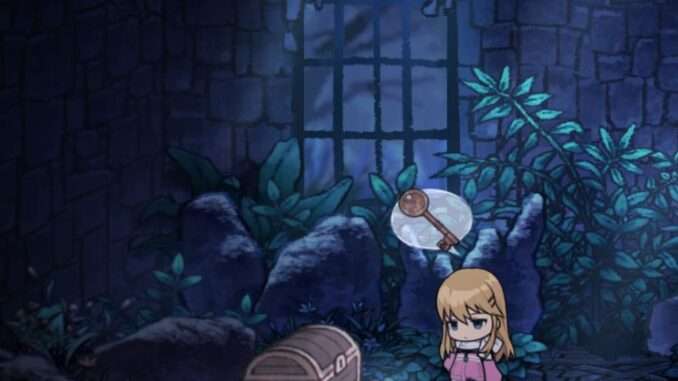
Action Count
Chrono Ark is a funny game where the enemies attack during your own turn. There will be a number next to the enemies’ health bar, and this number indicates that the enemy will attack after X action counts. Every time you use a skill, this number will decrease by 1 and when it hits 0, the enemy will act. However, skills with swiftness will not reduce the enemy’s action count, so be on the lookout for them!

Little Maid will act in 1 count, and Soldier Statue will act in 2 counts.
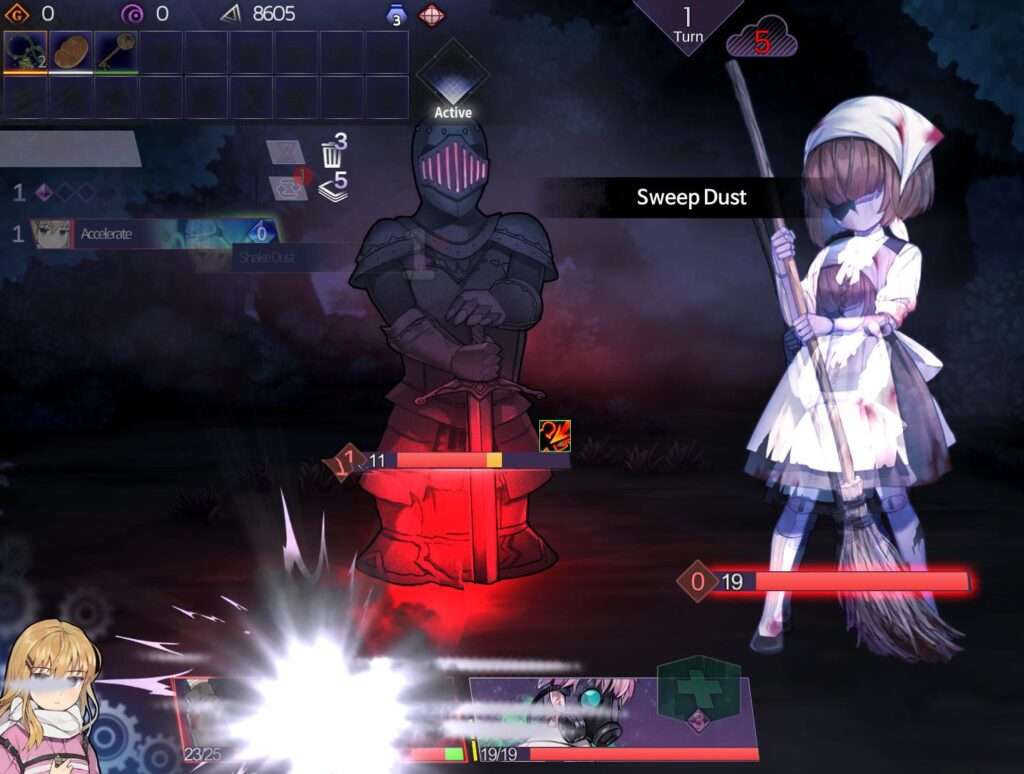
Since Little Maid’s action count hit 0, it will now attack you.

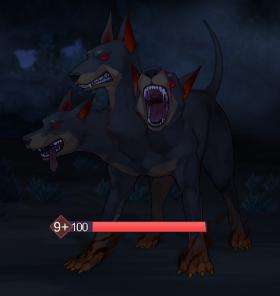
You see how Cerberus has an additional action stacked onto it? This means Cerberus will attack in 1 count, and then attack again after you end your turn.
If several enemies have tied counts, that is they reach 0 at the same time, they act in order from right to left.
Player skills with the Countdown keyword behave in a similar manner.

Instead of being cast immediately when played, they go into a “casting list” and will be cast once the countdown reaches zero.

In the example above, Storming Blade will be cast after playing one non-swift skill and Blade Starfall after two. If both skill and enemy reach zero count at the same time, player skill takes priority and will be cast before the enemy acts.
Hourglass
The hourglass can be used to wait and lower every action count by 1. That applies both to enemies and skills in the casting list. By default, waiting once per turn is permitted and an extra wait action is added for each point of speed up to 3 waits total.

“Why would I ever want to wait and let the enemy act before me?” you might ask. Well, letting enemies take several actions in a row without being interrupted is equivalent to giving the wheel to rng. As enemies don’t show their intentions and often attack randomly (most bosses being a notable exception), sequenced enemy actions deprive the player of control and can result in characters fainting in an unlucky targeting or crit streak.

Consider the situation above. Ending the turn right now would result in the Butler-Maid duo smacking your team 4 times in a row. The maid has an attack that applies bleed and unless you get a lucky dodge the consequences will be tragic. If you instead waited twice and let the maid take action, you could respond by casting a basic heal negating most of the damage dealt, and using an extra sword to finish off the butler. Much better scenario than before.
That’s the most basic way of countering enemy actions. As you get more familiar with the game other options will become available such as Lian’s Parries.
Speed
Speed is a stat directly responsible for determining action counts. You can think of 1 point of party speed delaying enemy action counts by 1 and negative value decreasing them. Not all enemies are made equal and some tend to act faster. This is due to every individual enemy having an internal speed value however there’s still a dice roll involved. Some enemies like Cerberus or Parade tank ignore speed mechanic whatsoever and act on preset action counts.
Generally speaking, speed is very handy in later stages like White Graveyard and Sanctuary where the mobs and bosses can often attack you before you get to use your skills, which greatly increases the risk of someone dying. I recommend getting 1-2 speed for White Graveyard and Sanctuary, and this can be achieved through any of the speed boosting items or Swiftness Scrolls. Most notably, you can prevent Reaper, Sacred Karaela, and The Forgotten King from outspeeding you as long as you have 1 Speed.
Too much speed can be detrimental. As explained in hourglass section, being able to respond to enemy actions is a powerful tool and speed increasing action counts too much can deny that possibility. Increasing speed by up to 2 points has no side effects as each extra point of speed yields extra standby actions (clicking on hourglass). It stops increasing after 3.
Black fog also affects enemy speed. This often forgotten effect increases enemy speed by 1 on first turn of black fog by 2 on second by 3 on third and so on. Keep this in mind when stalling a fight.
Draw System
You can only draw 2 skills per turn, but they stay on your hand permanently. This means that you can keep a stun or high-quality skill in your hand until you really need it. Draw skills are very important because in the later stages in the game, you will have situations where you have a ton of mana lying around but no cards to use in your hand. Make sure to have enough draw skills to keep your hand filled up. This is especially important for skill spammers like Azar and Johan.
At the start of the battle, the number of skills drawn is 2 + (number of investigators alive). If a character dies and your hand contained the skills of that character, some skills will be drawn as compensation.
Beware that you can only hold up to 10 skills in your hand (Toggle “Show skill count” in the game options for quality of life), any draws that make your hand go beyond this number will push the topmost skill(s) to the discarded deck.
Cycling
TLDR: Think about cycling your cards every turn.
Cycling or exchanging is a core card management mechanic hidden behind this tiny recycling looking button in the top left corner of the screen.

Clicking the button or holding Shift will allow cards to be cycled. Selected card will be discarded and a new one will be drawn. By default, one cycle per turn is allowed.
Some cards, for example, the ones with Bind or Exclude keywords cannot be cycled and will be discarded/removed instead. Cycling is also a primary way of removing stuns from characters. Attempting to cycle a skill owned by a stunned character will discard the card and remove the stun. This does NOT work with other CC debuffs.
However, the power of cycling does not lie in the ability to remove stuns but rather in pseudo card draw. This might not seem as such a big deal at first glance but you have to consider that only 2 are drawn per turn as hand is not discarded at the end of the turn. That means most of the time there are undesirable skills such as basic heals/attacks accumulating in the hand. This is particularly true in 1.7 where availability of character unique skills is somewhat reduced. Cycling is an essential tool of getting through the slog of your deck and getting to good skills or draw skills faster.
As a rule of thumb, I wouldn’t say that cycling every turn is a must. There are situations where keeping cards for set-up or countering anticipated enemy actions is a valid choice. Timing of cycle should also be considered, as doing it too early leaves fewer options of removing stuns.
However, too often I’ve seen people forgetting or outright not knowing about cycling. And Chrono Ark draw mechanics rely on cycling to keep a constant flow of cards going. Therefore, one should get into a habit of considering cycling every turn.
Health and Healing
Chrono Ark has a slight twist on traditional rpg healing system (cuz ofc it does). When player character gets hit part of their health bar becomes green. That green bit is referred to as healing gauge and while it doesn’t represent actual hp it has several important properties.
At the end of the battle all hp in healing gauge will be restored and turned into true hp. Healing skills restore hp in healing gauge without a penalty. In comparison, heal outside healing gauge is only 33% efficient on expert difficulty and 40% efficient on normal. Healing with Overheal property ignore this and always heal at 100% even in black fog!
If a character who has healing gauge remaining get damaged again, the current healing gauge will be destroyed turning health bar greyish and a new hg will be given depending on the damage taken. Pain damage (usually from damage over tick sources) does not destroy healing gauge. Additionally, there are plenty of effects granting hg protection such as Miss Chain’s burn.
Healing Gauge Explained
Healing Gauge is one of the core feature of Chrono Ark.
Healing Gauge is a part of the Investigator’s Health Bar, more specifically, the green bar. It represent the health you just lost, or more if you have Healing Gauge Protection.
When casting an healing skill, Health inside the Healing Gauge will be restored for 100% of that skill’s healing amount. Health outside the Healing Gauge (black bar) however will be restored for 33% of the value of your Healing Skill.
True Health (the red bar) can be restored directly by “Overhealing”, “Overheal” is a feature on most health-restoring items and a keyword on a few skills.
Overload
If a character casts a skill, that character will gain overload, and the cost of their skills will increase by 1. However, skills with Swiftness will not overload your character, and its cost will not rise due to overload. Let’s say that you have 3 cards – Hein’s Basic Attack, End of the Line, and Accelerate. A purple gem on the skill’s cost indicates skills with no Swiftness and a blue gem indicates skills with Swiftness.
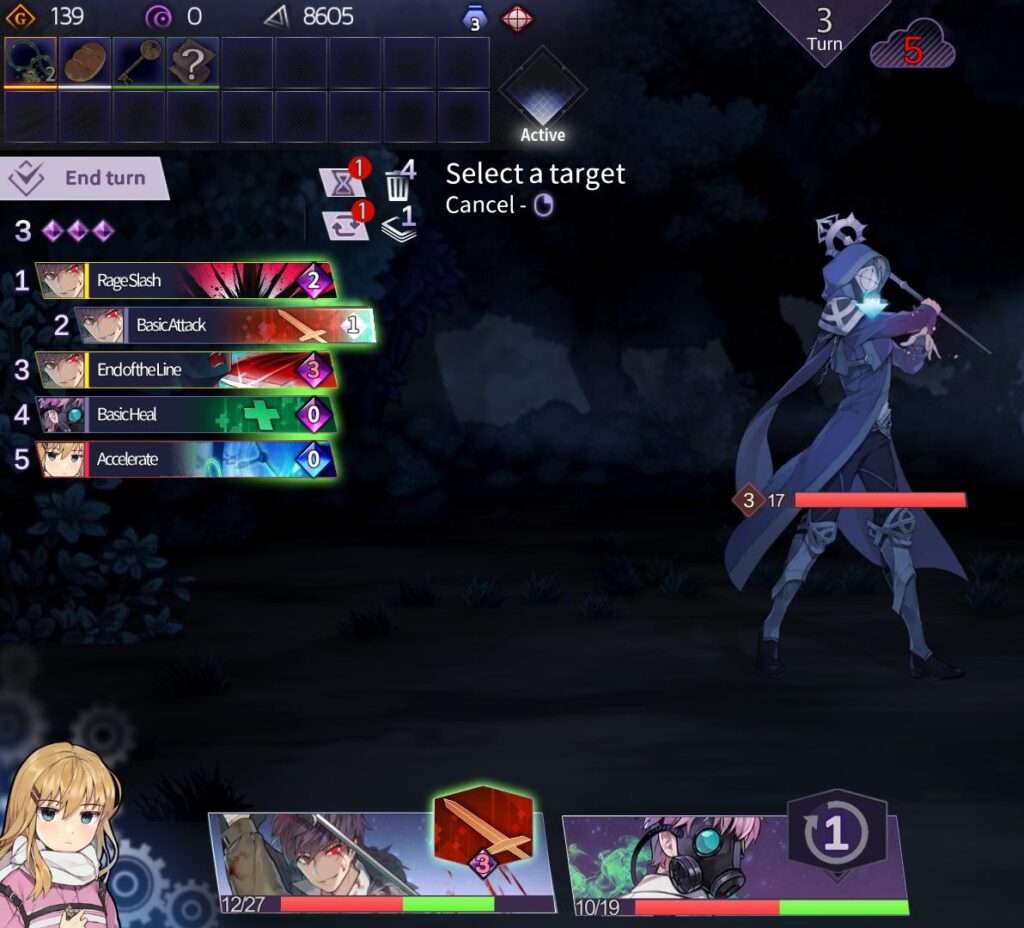
After casting Hein’s Basic Attack, End of the Line will increase to 3 costs due to overload.

Hein has gained 1 overload due to casting Basic Attack. However, I used Accelerate on End of the Line, which means its cost has been reduced by 1 AND it has gained swiftness (not affected by overload), so it is now 1 cost.
Note the yellow bar next left to Hein’s portrait. It indicates that he has one stack of overload. Overload caps at 3 stacks and is reset at the end of the turn. Lucy gets overloaded as well, but there is no cap for lucy overload and there’s no UI element keeping track of it.


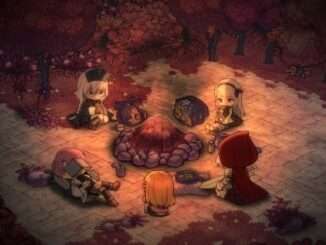
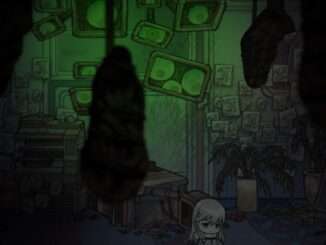
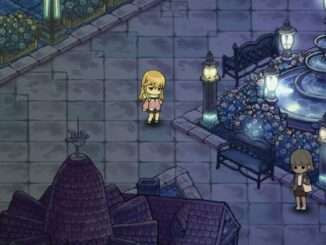
Be the first to comment